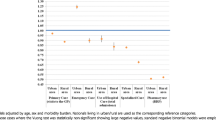Abstract
It is difficult to trace full details of the path which irregular or illegal immigrants follow when seeking assistance in the network of the various hospital departments and health structures. The aim of this work was to analyze the health needs of immigrant people by reviewing the types of treatment given to them in the day-hospital of our Department of Migration Medicine. Our study analyzed day-hospital admissions between 2003 and 2009. The patient charts used for managing day-hospital activity were adopted in 2002 in conformity with the “OSI project”. From these it is possible to draw up a scale picture of the distribution of each pathology in the immigrant population. The sample population consisted of 1,758 subjects, representing 7.4% of potential users. More than half came from Africa, followed by Asia, and then Europe. Gastroenterological diseases ranked first, with dyspeptic syndromes most frequently diagnosed. Infections and parasitic diseases ranked second, and the most frequent diagnoses were sexually transmitted diseases. Third were diseases of the genitourinary system. Metabolic disorders ranked fourth, among them, more than half of the cases were of diabetes mellitus, in patients from south-east Asia. Diseases of the circulatory system were sixth, with hypertension the most frequent pathology. Our data confirm a marked persistence of the phenomenon known as the “healthy immigrant effect” in these types of patients, as well as the prominent role played by “social determinants” in conditioning the health of immigrants, particularly in the case of some infectious diseases.


Similar content being viewed by others
References
La salute della popolazione immigrata: metodologia di analisi. Progetto: promozione della salute della popolazione immigrata in Italia. Accordo Ministero della salute/CCM--Regione Marche (Direzione Generale Prevenzione Sanitaria, Ufficio I, n. DG/PREV/I 3488/P/F 3 ad, 2007)
Geraci S (2007) La salute degli immigrati: luci ed ombre. Asi, anno XV, n. 44:331
Affronti M (2001) Untori o unti? Casi clinici paradigmatici di medicina delle migrazioni. Ann Ital Med Int. 16(suppl. 1):172S–175S
Marceca M, Geraci S, Ardirò M (2006) Esperienza migratoria, salute e disuguaglianze. Rapporti Istisan 07(14):19–24
Progetto OSI. Sperimentazione di un sistema informativo sanitario sull’assistenza di primo livello agli immigrati. Progetto di ricerca finalizzata ex art. 12 bis, comma 6, D.Lgs. 229/99. ASP Lazio monografie 2006
Immigrazione Dossier Statistico 2010: XX Rapporto Caritas/Migrantes; Centro Studi e Ricerche IDOS, Roma
Barnett E, Walker PF (2008) Role of immigrants and migrants in emerging infectious diseases. Med Clin North Am 92:1447–1458
Majori S, Baldo V, Tommasi I et al (2008) Hepatitis A, B and C infection in a community of sub-Saharian immigrants living in Verona (Italy). J Trav Med 15:323–327
Ahmed F, Foster GR (2010) Global hepatitis, migration and its impact on Western healthcare. Gut 59(8):1009–1011
Geraci S, Baglio G. Salute degli immigrati. RapportoOsservasalute 2008
Horton R (2005) The neglected epidemic of chronic diseases. Lancet 366(9496):1514
Agyemang C, Addo J, Bhopal R et al (2009) Cardiovascular disease, diabetes and established risk factors among populations of sub-Saharan African descent in Europe: a literature review. Global Health 11(5):7
Chandak GR, Idris MM, Reddy DN et al (2004) Absence of PRSS1 mutations and association of SPINK1 trypsin inhibitor mutations in hereditary and non-hereditary chronic pancreatitis. Gut 53:723–728
Schneider A, Suman A, Rossi L et al (2002) SPINK1/PSTI mutations are associated with tropical pancreatitis and type II diabetes mellitus in Bangladesh. Gastroenterology 123(4):1026–1030
Fedeli U, Alba N, Lisiero M et al (2010) Obstetric hospitalizations among Italians women, regular and irregular immigrants in North-Eastern Italy. Acta Obstet Gynecol Scand 89:1432–1437
Acknowledgments
We wish to thank Ms. Carole Greenall for the revision of the English style.
Conflict of interest
None.
Author information
Authors and Affiliations
Corresponding author
Rights and permissions
About this article
Cite this article
Affronti, M., Affronti, A., Pagano, S. et al. The health of irregular and illegal immigrants: analysis of day-hospital admissions in a department of migration medicine. Intern Emerg Med 8, 561–566 (2013). https://doi.org/10.1007/s11739-011-0635-2
Received:
Accepted:
Published:
Issue Date:
DOI: https://doi.org/10.1007/s11739-011-0635-2



